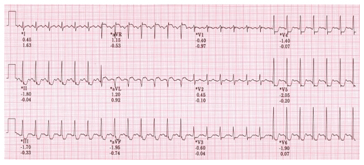Overview
Treadmill test (TMT) or Stress Test
Treadmill test (TMT) or exercise stress test is one of the commonest forms of stress tests used to induce provokable myocardial ischemia for diagnostic evaluation of coronary artery disease. Other forms of stress test are dobutamine stress echocardiography and adenosine stress test. In treadmill exercise test, the subject walks on a treadmill as per the protocol of the test. One of the commonest protocol used is known as Bruce protocol. Every stage of Bruce protocol consists of three minutes. The starting speed is 1.7 miles per hour (mph) and the gradient is 10%. 0.7-08 mph increment in speed and 2% increment in gradient is given for each consecutive stage. Usual Bruce protocol has upto 7 stages, but most often when it is done in a post myocardial infarction patient, upto 10 minutes of exercise is taken as sufficient.
The heart rate and blood pressure are monitored continuously along with 12 lead ECG with computerised ST and arrhythmia detection algorithms. Test is stopped if the subject develops limiting angina, syncope, breathlessness, fatigue or when the target heart rate is achieved. Significant ST depression of 3 or more millimeters is also an indication for termination. Occasionally the test has to be terminated because of serious cardiac arrhythmia. A defibrillator and qualified personal and equipment for resuscitation should be available during the test.
Significant ST depression developing at lower workloads (less than 5 MET) especially if associated with typical symptoms is highly suggestive of inducible ischemia. Downsloping ST depression is most significant while horizontal ST depression is of lesser significance. Upsloping ST depression of least significance. ST depression more than 5 minutes into recovery is also highly significant. The leads in which ST depression occurs do not indicate the region of ischemia usually. But if ST elevation occurs, it is supposed to be indicative. ST elevation occurring in leads with Q waves indicate viable myocardium in the infarcted territory.

[Peak exercise ECG tracing showing significant horizontal ST depression in inferior and lateral leads.]
The list of of Health Check up and screening Hospitals in India is as follows : -
 |
Apollo Hospitals, Bangalore, India |
 |
Apollo Hospital, Chennai, India |
 |
Apollo Hospitals, Hyderabad, India |
 |
Indraprastha Apollo Hospital, Delhi, India |
 |
Apollo Gleneagles Hospital, Kolkata, India |
 |
Apollo Hospital, Goa, India |
 |
Wockhardt Hospital, Bangalore India |
 |
Wockhardt Hospital, hyderabad, India |
 |
Wockhardt Hospital, Mumbai, India |
 |
Wockhardt Hospital and Kidney Institute, Kolkata, India |
 |
Fortis Hospital, Delhi, India |
 |
Fortis Hospital, Mohali, India |
 |
Fortis Hospital, Noida, India |
 |
Escorts Heart Institute Hospital, Delhi, India |
 |
Manipal Hospital, Bangalore, India |
 |
MIOT Hospital, Chennai, India |
 |
Narayana Hrudayalaya Heart Hospital, Bangalore, India |
 |
Sparsh Hospital, Bangalore, India |
 |
Narayana Cancer Hospital, Bangalore, India |
 |
Artemis Hospital, Gurgaon ( Delhi ) , India |
 |
Max Super Specialty hospital, Delhi, India |
 |
Max Devki Devi Heart and Vascular hospital, Delhi, India |
 |
Max Health Check Centre, Delhi, India |
 |
BGS Global Hospital, Bangalore, India |
 |
BGS Global Hospital, Chennai, India |
 |
BGS Global Hospital, Hyderabad, India |
|
For more information, medical assessment and medical quote
send your detailed medical history and medical reports
as email attachment to
Email : - info@wecareindia.com
Call: +91 9029304141 (10 am. To 8 pm. IST)
(Only for international patients seeking treatment in India)
| |
|
|
For a detailed evaluation send patientís medical reports / X rays / doctors notes to info@wecareindia.com
|
| |
|
| |
